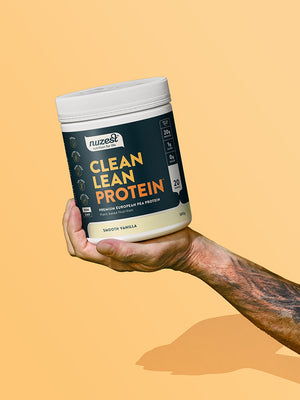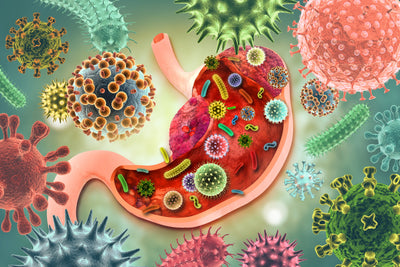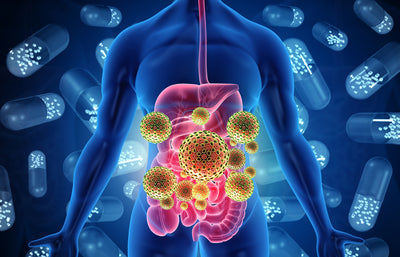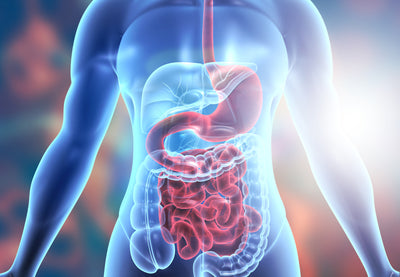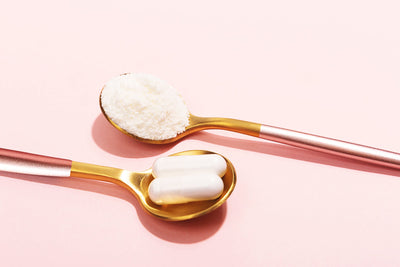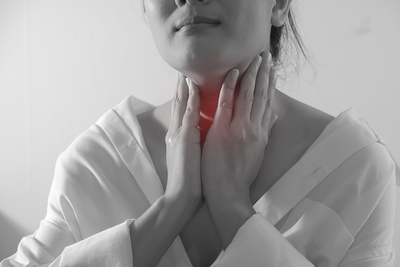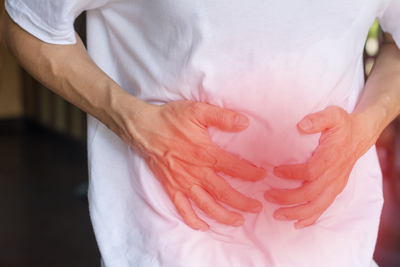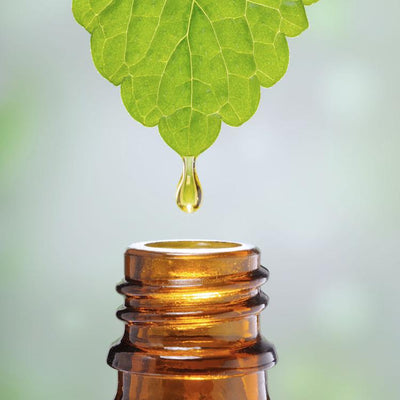
10 min read
Detox Diets Part 2: How Dangerous Are Common Toxins?
Posted By
Caitlin Turner
Written by Cliff Harvey, PhD, DipFit, DipNat
What Are Toxins?
Toxins are poisonous substances that are produced either within the body or by another organism (synthetically created ‘toxins’ are technically called toxicants).
Are Toxins Dangerous?
While they sound scary (and some are!), many toxic chemicals are actually produced as part of normal bodily processes.
In fact, it is not uncommon for tiny amounts of toxins to be ingested as part of a normal healthy diet, or as a result of environmental exposure.
Products that we are exposed to daily such as household cleaners, medications, alcohol, pesticides, fuel and cosmetics can all be considered toxic in certain conditions.
So, it’s important to remember the old adage, the dose defines the poison!

What Are Some Common Toxins?
There are many different types of toxins, all of which vary greatly in the severity of their effect. We discuss some of the most common toxins and their effect on health below.
1. Heavy Metals
Heavy metals are metals with high densities or atomic weights. They include nutrients such as iron, cobalt and zinc.
These nutrients are essential for health and yet, are toxic in large doses.
When people refer to heavy metals in the context of health, they are typically referring to metals such as lead, cadmium, arsenic and mercury.
These heavy metals are toxic, even in the smallest amounts.
2. Arsenic
Arsenic is a natural component of the earth’s crust and is widely distributed throughout the environment in the air, water and land.
It is because of this that minute doses of arsenic can be found in some drinking water and foods. Interestingly, emerging research indicates that arsenic might be an essential trace nutrient 1, however elevated levels of arsenic are highly toxic and very dangerous.
Based on mammalian studies, a recommended dose of arsenic per day for health is between 12.5 and 25μg, and people take in around 12-50μg per day through a normal diet1,2.
The World Health Organization (WHO) has set a safe limit of <10μg /L for drinking water.
3. Cadmium
Cadmium is a heavy metal found commonly in the environment from natural occurrence and contamination.
Smokers have a high exposure to cadmium through cigarettes, while everyday foods are the highest source of cadmium for the non-smoking population.
Foods contributing most to dietary cadmium are cereals and cereal products, vegetables, nuts and pulses, starchy roots or potatoes, and meat and meat products.
Vegans and vegetarians can have higher exposure to this heavy metal due to their high consumption of cereals, nuts, oilseeds and pulses.
Over exposure to cadmium can cause kidney failure, bone demineralisation and be carcinogenic. The average levels of cadmium in food have been found to be ≈200μg/kg3, with a tolerable amount of 7μg/kg body weight, per week (or ≈76μg per day), being previously set by the European Food Safety Authority.
4. Lead
Lead is a major contaminant of drinking water and food and is extremely toxic at even small doses.
Once in the body, lead circulates in the blood and can be stored in the bones.
The health effects from lead exposure will vary depending on a variety of factors such as a person’s age and the amount and timing of lead exposure.
In infants, lead exposure has been shown to hinder neuronal development1.
5. Mercury
Mercury poses severe risks to the development of children in utero and in early life. A tolerable amount has been set by the World Health Organization of 1.6μg/kg body weight, per week 4, or ≈17μg per day for a woman of average weight.
6. Bisphenols
Bisphenols such as bisphenol A (BPA) and bisphenol S (BPS) are chemical ‘plasticisers’ that function as raw materials for the production of many plastics including storage containers, food and beverage packaging, and lacquers and sealants for a range of other products (such as the BPS containing treatments on thermal cash register receipts)5.
These plasticisers have been found in food, house dust, rivers and lakes, and personal care products6,7, and have been identified in human sera, saliva, and urine8.
They are known to cause appreciable health harms and are toxic to a range of animals and organisms, including humans9,10.
As knowledge of the harms of BPA have become more well known, there has been a movement towards using different bisphenols in the place of BPA.
This has led to an increase in exposure to other chemicals, in particular BPAF, BPF, and BPS and this has resulted in similar or even greater levels of exposure and accumulation of these chemicals in humans11.
The various bisphenols; BPA, BPAF, BPB, BPF, and BPS have been shown to exhibit anti-thyroid, oestrogenic or antiandrogenic properties along with hormone-disrupting effects, toxicity and damage to both cells and genes, reproductive toxicity, immune dysfunction, dioxin-like effects, nephrotoxicity, and neurotoxicity (toxicity to the brain and central nervous system) and are carcinogenetic (cancer-causing chemicals)10-13.
7. Glyphosate
Glyphosate (commercially often seen as “Roundup”) is an extremely common herbicide. Its use has become so common that glyphosate residue can be found in many foods, water, and commonly used products (including medical gauze, tampons and personal care products).
While it has been listed as a probable carcinogen by the International Agency for Cancer Research, its effects on human health are controversial, with some claiming that the chemical is safe in the amount humans are exposed to, while others claim there are very real health risks from low-dose exposure.
Overall, the effect of glyphosate on health is likely to be very complex in nature as there are potential effects on hormones, and likely detrimental effects on the microbiome, which require further research 14.
Read more
Detox part 3: How to support your bodies natural detox ability...
References
- Hunter P. A toxic brew we cannot live without. Micronutrients give insights into the interplay between geochemistry and evolutionary biology. EMBO Reports. 2008;9(1):15-8.
- Uthus EO. Evidence for arsenic essentiality. Environmental geochemistry and health. 1992;14(2):55-8.
- IARC. Cadmium and Cadmium Compounds. WHO International Program on Chemical Safety; 2012.
- Organisation WH. Exposure to mercury: A major health concern. Geneva, Switzerland: World Health Organisation; 2007.
- Bernardo PEM, Navas SA, Murata LTF, Alcântara MRdSd. Bisphenol A: review on its use in the food packaging, exposure and toxicity. R Inst Adolfo Lutz. 2015:1-11.
- Pelch K, Wignall JA, Goldstone AE, Ross PK, Blain RB, Shapiro AJ, et al. A scoping review of the health and toxicological activity of bisphenol A (BPA) structural analogues and functional alternatives. Toxicology. 2019;424:152235.
- Raffaelina M, Santonicola S. Investigation on bisphenol A levels in human milk and dairy supply chain: A review. 2018.
- Usman A, Ikhlas S, Ahmad M. Occurrence, toxicity and endocrine disrupting potential of Bisphenol-B and Bisphenol-F: A mini-review. Toxicology Letters. 2019;312:222-7.
- Huang YQ, Wong CKC, Zheng JS, Bouwman H, Barra R, Wahlström B, et al. Bisphenol A (BPA) in China: A review of sources, environmental levels, and potential human health impacts. Environment International. 2012;42:91-9.
- JT Gowder S. Nephrotoxicity of bisphenol A (BPA)-an updated review. Current molecular pharmacology. 2013;6(3):163-72.
- Chen D, Kannan K, Tan H, Zheng Z, Feng Y-L, Wu Y, et al. Bisphenol Analogues Other Than BPA: Environmental Occurrence, Human Exposure, and Toxicity—A Review. Environmental Science & Technology. 2016;50(11):5438-53.
- Ohore OE, Zhang S. Endocrine disrupting effects of bisphenol A exposure and recent advances on its removal by water treatment systems. A review. Scientific African. 2019;5:e00135.
- Matuszczak E, Komarowska MD, Debek W, Hermanowicz A. The Impact of Bisphenol A on Fertility, Reproductive System, and Development: A Review of the Literature. International Journal of Endocrinology. 2019;2019:8.
- Davoren MJ, Schiestl RH. Glyphosate-based herbicides and cancer risk: a post-IARC decision review of potential mechanisms, policy and avenues of research. Carcinogenesis. 2018;39(10):1207-1
Related news
min read
An Introduction to Gut Health & Nutrition – 5 Must See Articles
Gut health significantly affects overall wellbeing, influencing brain function, immunity, and metabolism. A balanced gut microbiota, influenced by diet and environment, can potentially enhance health, aid digestion, and reduce allergies. The roles of probiotics and prebiotics in gut health are also discussed.
min read
Probiotics vs. Prebiotics
Unleash gut health with probiotics and prebiotics! Strengthen digestion, immunity, and overall well-being. Try Nuzest's Good Green Vitality for convenient support with 8 billion CFU of probiotics. Take charge now!
min read
The Link Between Gut Health & Allergies - Plus 5 Top Tips to Help
Discover the link between gut health and allergies, and how the gut microbiome influences the body's immune response to allergens. Learn how adopting a balanced diet with prebiotics and probiotics can support gut health, reducing the risk of allergic reactions. Explore solutions for allergy relief and fostering a healthier gut with Nuzest’s multi-nutrient formula, Good Green Vitality.
min read
The Great Diet Debate: Unravelling the Tapestry of Popular Eating Plans
Exploring popular diets such as the Mediterranean, Ketogenic, Plant-Based, Paleo, and Intermittent Fasting, this overview highlights their principles, benefits, and considerations. It emphasizes the importance of finding a dietary pattern that aligns with individual health goals and preferences, while suggesting the potential benefits of incorporating a multi-nutrient supplement for overall health.
min read
The Gut Connection: How to Improve Your Digestion and Gut Health in 6 Steps
Discover the significance of gut health and its impact on digestion and overall well-being in this insightful article. Learn six practical steps, including maintaining a balanced diet, staying hydrated, managing stress, and using antibiotics wisely, to promote a healthy gut and enhance vitality.
min read
Does Gut Health Affect Your Immune System? | Do These 6 Things
The gut microbiome, which consists of trillions of bacteria in our digestive tract, plays a crucial role in supporting our immune system and overall health. Consuming probiotics and prebiotics, staying hydrated, managing stress, limiting processed foods, and engaging in outdoor activity and exercise are effective strategies to promote a healthy gut and enhance immunity.
min read
What is Collagen? Types, Sources and Benefits of Supplementation
Collagen is essential for joints, bones, muscles, ligaments, tendons, cartilage, skin, hair and nails.2 It is one of the primary structural proteins of connective tissue and plays a crucial role in the body by cushioning, strengthening, hydrating, binding, and connecting tissues together.3 Connective tissues are able to provide physical and mechanical support through the collagen, elastic and reticular fibres
min read
Kids Good Stuff for Skin Health
How can you ensure your kids have healthy skin? A part from the obvious, what nutrients can we provide our kids to ensure their skin stays in tip top shape?
min read
Maximising Mood In Your Kids
Almost 1 in 7 children and adults aged 4-17 had been diagnosed with a mental health disorder. Amy Butler discusses good nutrition and lifestyle modifications, that can help to reduce the risk.
min read
Long-Lasting Energy For Kids
Children and adolescents are going through massive periods of growth and development. To keep up with the demands of school, extracurricular activities, sports and friendships, kids often need a bit of an energy boost. In our latest blog we break down some specific nutrients for energy, to help support growing kids, and the best places to source them from.
min read
Setting Health Goals & Staying Motivated in 2021
Use this tried and tested goal strategy to set smaller, specific goals to avoid the overwhelm of unrealistic and vague health objectives.







